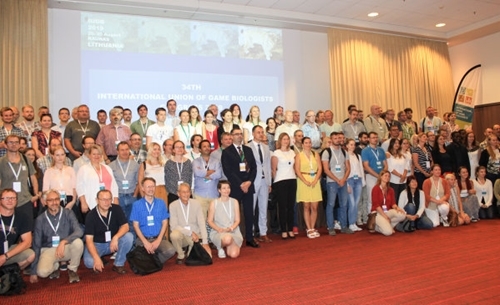Written by Mike Short, GWCT Predation Control Studies

I’m sometimes asked by friends involved with game shooting, what is the IUGB? Well, The International Union of Game Biologists is a diverse group of academics and managers that work towards the sustainable use of game and wildlife resources. It’s interested in everything from Moose and Muntjac to Wild turkeys and Woodcock, as well as the non-game species that interact with them and share their habitats. The IUGB promotes knowledge-exchange and networking opportunities between game and wildlife experts, principally through the organisation of an international Congress every second year. This year it convened during the last week of August in Kaunas, Lithuania, and a small team of scientists from GWCT attended to fly our flag and promote our research.
Key themes for this year’s Congress included: Human-wildlife conflict and its mitigation; Predator-prey relationships and carnivore management; Invasive species management; and Wildlife habitat management and behavioural ecology. All topics are highly relevant to the challenges we face in Britain. A series of Plenary lectures, Workshops, Oral and Poster presentations filled the agenda and fellow GWCT predation scientist, Tom Porteus, and I were fortunate to be able to present our research to a diverse international audience.
I spoke to delegates about our fox research in the Avon Valley, where I’ve used snares to catch foxes and fit them with GPS-trackers, to study their movements and behaviour around breeding waders. This novel insight will underpin new science-borne advice on the most appropriate predation control measures. Foxes can be difficult to manage; they contribute to the poor breeding success of many different meadow and shorebirds right across Northern Europe, and with addressing biodiversity loss high on Government agenda’s, understanding how to effectively mitigate against the impact of common predators is a priority for wildlife managers everywhere.
There was plenty of interest in our use of neck snares to live-catch foxes for tagging purposes, as we showed them to be highly selective and efficient. Despite GWCT research showing that when snares are used in accordance with ‘best practice’ guidance, they easily surpass international standards on humaneness for live-catching foxes, snares still receive a bad press and are not allowed in most European countries. However, with the invasive Raccoon dog (a small fox-sized wild dog native to Asia) and the rapid westward spread of Golden jackals in Europe, wildlife managers are looking towards capture methods beyond the use of cage traps and those that catch animals around the leg.
Tom presented some of his recent PhD work during the carnivore management session. Entitled “Evaluating alternative fox control strategies for the benefit of game and other wildlife species” he explained how the effect of culling on a fox population can be understood using complex Bayesian modelling techniques, and how these results can be used to determine the best fox culling strategy. Using fox culling records provided by gamekeepers (many of whom are GWCT members!) his modelling approach demonstrated that when the aim is to reduce the risk of fox predation on nesting birds, concentrating your culling effort in the spring and summer is more effective than the same effort applied uniformly throughout the year. This is important, because in some European countries, foxes are protected during their breeding season, despite the problems they are known to cause breeding ground-nesting birds of international conservation concern.
Given our prominent roles in the development of the GWCT mink raft, we were pleased to meet government agency staff from Norway, Sweden and Finland, where management of invasive species like American mink is a high conservation priority. FAMNA is an EU-funded Interreg project, that aims to demonstrate a new large-scale permanent and cost-effective management system for killing mink, reliant on the use of Goodnature traps – an innovative semi-automatic trap designed in New Zealand, that’s also approved in the UK for stoat, rat and grey squirrel control. The project is due to finish in 2020, so it’s not yet clear how effective and cost-efficient this trapping system will be for reducing mink numbers in Scandinavia, but we eagerly await the answer. Similarly, the jury is still out on how effective Goodnature traps will be for adequately suppressing numbers of stoats, rats and grey squirrels in Britain.
Attending international conferences like the IUGB costs money, but they really help keep research teams like ours on the ball, and on the map. It was heartening to hear from so many how highly they regard the GWCT’s science. The research department may comprise small specialist teams, but we have a big impact that helps the organisation retain its position as a global leader in delivering game and wildlife management advice. The next IUGB Congress will take place in 2021 in Budapest, Hungary, where we hope to help organise a special workshop on predation management.